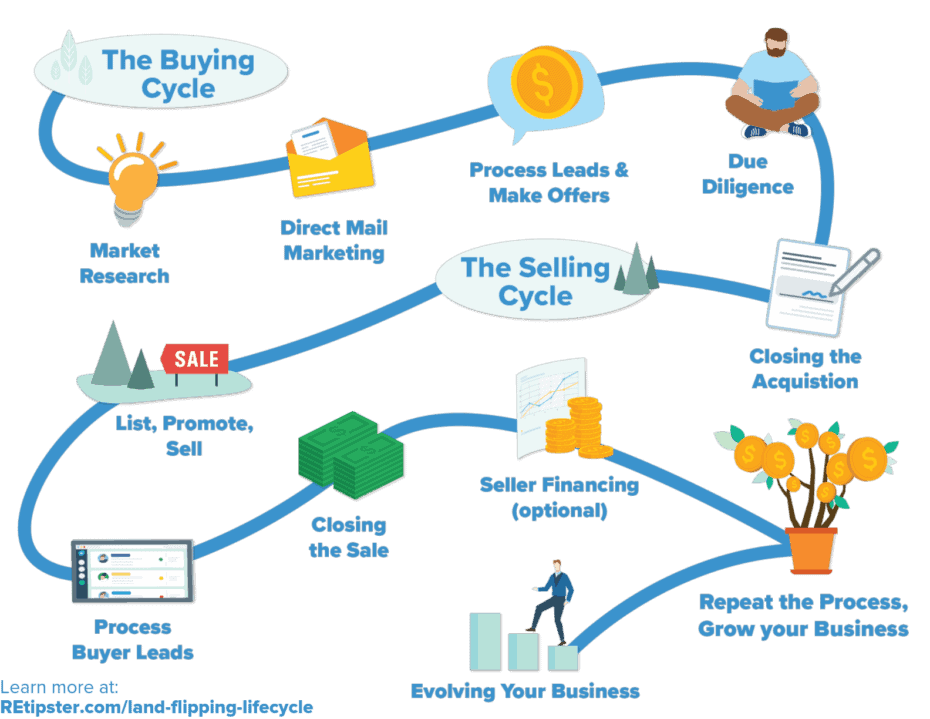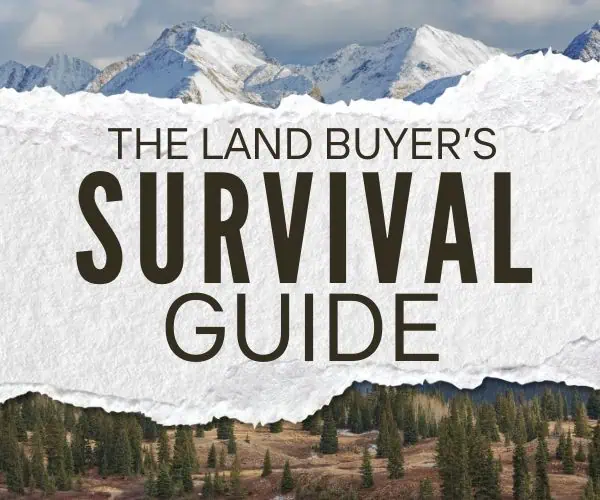Whenever people ask me what I do as a real estate investor, I'm often met with puzzled looks as I try to explain what “land flipping” or land investing is all about.
At first glance, these words are often misunderstood or confused with other investing models, and it's not surprising why.
Land flipping isn’t mainstream, and that’s exactly why it works. Most investors overlook it, which leaves plenty of opportunity for the ones who take the time to understand it. And if you’re curious—if you want to know how a simple plot of vacant land can turn into cold, hard cash—I’ll walk you through the whole process, step by step.
If you've ever wanted to know how the land flipping business works, I will lay out a clear roadmap of the “lifecycle” a vacant land deal goes through.
Of course, this is just one model that can be followed. This is the way I do it, but not every land investor goes through these exact motions (though most of us follow a pretty similar set of steps). As I've been working in this business over the past decade, this is the most systematic and sustainable way I've been able to nail down so far, and I hope you find it helpful.
Step 1. Market Research

- To the extent possible, define your ideal property (e.g., size, uses, zoning, location, value, etc.)
- Establish your budget for marketing and acquisition.
- Identify any state and local laws that may apply to vacant land transactions.
- Determine whether you intend to sell for cash or with seller financing (or both).
- Find out what property information is available from the county and/or your data service of choice.
RELATED: Finding Your Best Market for Land Investing
Step 2. Marketing for Motivated Sellers

Each marketing channel has pros and cons, but the success of any campaign hinges on your ability to find the right data, organize it adequately, and send a compelling message to the right people.
- Determine where you will get your list of property owners (the county or data service).
- Get your list filtered and sorted for the best possible response rate.
- Upload your list and direct mail piece to a direct mail service provider and send the mail!
- For non-direct-mail marketing, you'll want to skip trace your list to get phone numbers and email addresses and then contact the property owners.
RELATED: Text Marketing 101 for Land Investors
Step 3. Process Leads & Make Offers

- Set up a phone system (preferably, a customized voicemail greeting) to answer the sellers who choose to call you.
- Create a buying website to build credibility and allow sellers to submit their property information online.
- Respond to your inbound leads when necessary and gather the necessary information to close with confidence.
- Set up a FAST, seamless system for making non-committal offers. You can do this by sending out blind offers with your initial direct mail campaign (see Step 2) or emailing offers to each property owner.
- If any negotiation is required to get an acceptance, only have those conversations on the properties worth fighting for (and only revise your offer to the point that it still fits within the amount you're willing to pay).
RELATED: Boost Your Acceptance Rate By Asking This Question
Step 4. Due Diligence

- Find the property's location, shape, size, and dimensions, and verify that these aspects of the property are acceptable.
- Look closely at similar properties listed for sale in the area (and if data is available for sold comps, look at those, too). Try to nail down an approximate market value for your subject property.
- Check the property for potential issues affecting its uses (zoning, wetlands, terrain, surroundings, etc.)
- Make sure you understand all the costs associated with purchasing AND owning the property (back due taxes, recording fees, HOA fees, etc.). Even if you intend to sell the property as soon as possible, be fully informed about what it would cost to hold the property for a longer period, like 12 – 36 months.
- If adjustments need to be made to your offer price based on your findings, discuss this with the seller and revise your purchase agreement before closing.
RELATED: The Truth About Land Investing: 21 Warning Signs to Look for When Buying Vacant Land
Step 5. Closing the Acquisition

Another option is to be unconventional and close it yourself (this is far less expensive but requires more time and education). Self-closing only makes more sense for super-cheap properties because they have a smaller profit margin, and the cost of hiring a closing agent doesn't work with the deal's economics.
Closing a cash land transaction is fairly straightforward, but any real estate closing involves some inherent risk. The documentation, steps, and even the law can vary greatly depending on the state and municipality in which your property is located. You should only conduct your closings if you've done your independent research and verified the documentation and procedures required for your situation.
- Option 1: Do your title search to verify a clear chain of title and conduct an in-house cash closing (often makes sense for properties with a market value of less than $5K).
- Option 2: Send your signed purchase agreement to a professional closing agent and let them do all the work (often makes sense for properties with a market value of $10K or more).
- Option 3: Take the hybrid approach by ordering title insurance and closing the transaction yourself, with the help of a mobile notary, to get documents signed. Note: Title insurance will automatically be part of the package when you use a title company. When you close on your own, you can decide whether or not to buy title insurance (from a cost standpoint, this hybrid approach often makes sense for properties with a market value between $5K – $10K)
RELATED: Understanding Title Insurance: How to Read a Preliminary Title Commitment
Step 6. List, Promote, Sell

- Start by creating a compelling property listing with great pictures (even drone photography and video, if possible) and an informative description.
- Post your property listing in as many places as possible, and focus your efforts on the outlets with the highest traffic and/or the most targeted audience for land buyers.
- Price your property competitively (if you bought it at 10% – 30% of market value, this shouldn't be difficult), and it also helps if you're willing to offer seller financing whenever possible.
- Contact the neighbors and let them know about your property for sale.
- Build a buyers list and keep them informed of your available properties.
RELATED: 5 Fundamentals That Sell Real Estate Fast
Step 7. Process Buyer Leads

- Follow up with every email, text, call, and comment on your property listings and leave no stone unturned. It's usually not possible to determine if someone is a serious buyer on the first contact, so follow up with everyone.
- Ask qualifying questions to weed out the tire kickers and determine whether you're talking to a serious buyer. If someone indicates that they have the cash and are ready to buy, you'll have a good reason to keep the conversation going.
- Even if someone doesn't buy the property they're inquiring about, add them to your buyer's list and keep them informed about other properties in your inventory that might fit their needs.
RELATED: The Real Estate Investor's Guide to Building a Buyers List
Step 8. Closing the Sale

- When you've got an interested buyer who has verbally committed, it's time to schedule a closing date (signing a purchase agreement and collecting an earnest deposit aren't required, but both actions will signify the buyer's commitment to the deal).
- Depending on the deal's profit margin (and who pays the closing costs), it may make sense to enlist the help of a title company to handle all the paperwork and facilitate the closing.
- If the property has a smaller profit margin, the closing can be handled in-house by simply signing the deed to the buyer after being paid.
RELATED: How to Close a Cash Land Transaction In-House
Step 9. Seller Financing (Optional)

Seller financing can offer some huge advantages for land investors because most banks and credit unions won't offer loans for vacant land – and since most land buyers will have a harder time finding the funds to buy your property, you can solve this problem by financing the sale for them (and since you're acting as their lender, you'll have a lot of freedom and flexibility over what the terms will be).
- Do some homework to find out what type of lending instrument should be used in the state where your property is located.
- Consult with a legal professional to understand what will be required if a borrower ever defaults on their payments to you (i.e., In the worst-case scenario, how difficult, costly, and time-consuming will it be to repossess/resell your property)?
- Finalize the terms with your borrower, verify their ability to repay (optional), close the transaction, and start collecting payments.
- Get the right systems in place to automate the collection of payments, keep track of loan balances, and stay on top of borrowers if/when they pay late (or stop paying altogether).
RELATED: Seller Financing Masterclass Review
Step 10. Repeat & Grow Your Business

Take some time to analyze how everything progressed through the previous steps.
- What went well?
- What could have gone better?
- What can you change to smooth out the process?
Think about how you can navigate the lifecycle more efficiently, sustainably, and profitably.
- Should you work in a different market or stay in the same place?
- Should you go after similar property types or pursue something different?
- Should you change the way you handle prospects and make offers?
- Which marketing mediums were most effective for you in the selling process?
- Where should you be spending more (or less) time and money?
- Was it easy or difficult to get your property sold? Why?
- If it was difficult, what would have made it easier?
- If it was easy, should you have asked for more?
Make any necessary adjustments to your game plan and jump back into it!
If you've made it through the lifecycle, give yourself a BIG pat on the back!
Many people burn out somewhere in the previous steps because land flipping is like any business – unexpected challenges WILL come up, things DON'T always happen as quickly and seamlessly as we'd like them to, and it takes patience and stamina to keep pushing forward.
RELATED: The #1 Reason Land Investors Fail
Step 11. Evolve Your Business

For most people, land investing is a means to an end – so whatever your end goal is, be intentional about moving your business and life in that direction.
- If you want to diversify your income by investing in other things, then make sure you've set aside a budget for it!
- If your goal is to build up dozens (or hundreds?) of passive income streams from seller-financed land deals, then make sure you're selling your properties this way!
- If your goal is to quit your job and spend more time with your family, then make sure you've got a game plan to quit your job and make more time for your family!
I know from experience even when you've got a business that runs like a well-oiled machine, it's easy to let the business run you rather than you running your business. Whatever your long-term goals are, don't forget to keep those goals in mind as you make short-term decisions.
RELATED: The Real Problem With Your Ambition (And How to Avoid It)
Want to Learn More About Land Investing?

If you want to get the inside scoop on how to start and run your own land investing business, come and check out the Land Investing Masterclass, where you'll get access to a full 12-week course, videos, bonuses, downloads, and a members-only forum (where I spend time answering questions every week). There is no better place to learn this business from the inside out.











